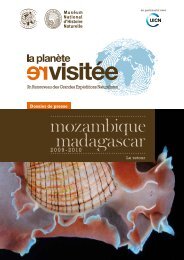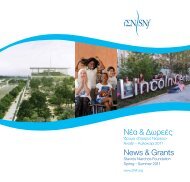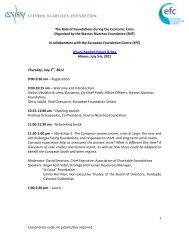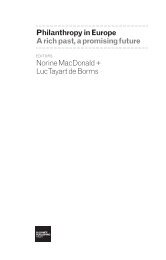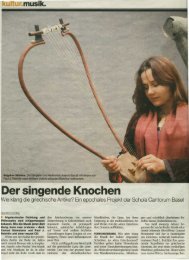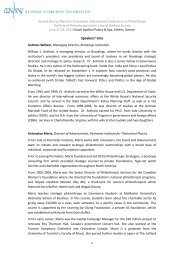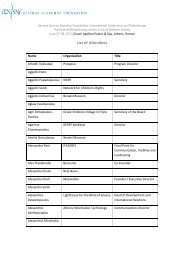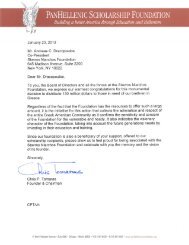Speech by the CEO and Managing Director of the SNFCC AE, Mr ...
Speech by the CEO and Managing Director of the SNFCC AE, Mr ...
Speech by the CEO and Managing Director of the SNFCC AE, Mr ...
Create successful ePaper yourself
Turn your PDF publications into a flip-book with our unique Google optimized e-Paper software.
The <strong>SNFCC</strong> <strong>and</strong> Public Private Partnerships as a Means <strong>of</strong> Promoting<br />
Social Welfare<br />
Dear Guests,<br />
As you are aware, <strong>the</strong> acute crisis that Greece has been experiencing is well<br />
into its 6th year. This is a crisis that began as an economic crisis, but quickly<br />
evolved into a political, a social <strong>and</strong> a cultural crisis. It is now clear that we are<br />
experiencing, above all, a crisis <strong>of</strong> identity, orientation <strong>and</strong> values. We realize<br />
that <strong>the</strong> way we have been living has changed irreversibly. We have to rethink<br />
our manner <strong>of</strong> conduct <strong>and</strong> to reformulate our modus vivendi.<br />
Before <strong>the</strong> crisis most people felt that <strong>the</strong>y could create <strong>the</strong>ir own <strong>and</strong> <strong>the</strong>ir<br />
loved ones’ enclave <strong>of</strong> happiness <strong>and</strong> prosperity solely <strong>by</strong> <strong>the</strong>ir own means.<br />
The creation <strong>of</strong> <strong>the</strong> conditions for <strong>the</strong> general social <strong>and</strong> collective welfare<br />
were seen as <strong>the</strong> responsibility <strong>of</strong> “somebody else”. This “somebody else” in<br />
most cases was considered to be <strong>the</strong> state. The state was responsible for<br />
keeping parks <strong>and</strong> public spaces clean, for building <strong>and</strong> maintaining<br />
infrastructure, for ensuring that our children get a good education. This was<br />
our society before <strong>the</strong> crisis hit us: a society <strong>of</strong> institutionalized individuals.<br />
The crisis, however, has put an abrupt end to <strong>the</strong> above situation. The burden<br />
<strong>of</strong> <strong>the</strong> provision <strong>of</strong> welfare is now diffused much more widely <strong>and</strong> creates<br />
moral imperatives for everyone with <strong>the</strong> means to do so, to contribute. Public<br />
1
Private Partnerships (PPPs) are one <strong>of</strong> <strong>the</strong> methods that one has at <strong>the</strong>ir<br />
disposal in order to act according to <strong>the</strong> above moral imperative.<br />
The Stavros Niarchos Foundation, having recognized <strong>the</strong> severity <strong>of</strong> <strong>the</strong><br />
issues currently faced <strong>by</strong> Greece, has taken a number <strong>of</strong> initiatives. First, it<br />
took <strong>the</strong> ad hoc initiative to provide 100 million euro in additional support –<br />
above <strong>and</strong> beyond its regular activities – against <strong>the</strong> social impact <strong>of</strong> <strong>the</strong><br />
major crisis plaguing our country. Second, <strong>the</strong> Foundation’s regular activities<br />
aim at complementing <strong>the</strong> actions <strong>of</strong> <strong>the</strong> state <strong>and</strong> have provided crucial funds<br />
<strong>and</strong> support for many NGOs that do vital work in <strong>the</strong> fields <strong>of</strong> general welfare<br />
in Greece <strong>and</strong> abroad.<br />
The Stavros Niarchos Foundation Cultural Center, which is a combination <strong>of</strong><br />
<strong>the</strong> above two types <strong>of</strong> initiatives, is implemented via a Public Private<br />
Partnership. The latter vary in subject matter, scope <strong>and</strong> methodology.<br />
However, <strong>the</strong>re are common characteristics <strong>of</strong> such partnerships <strong>and</strong> <strong>the</strong><br />
European Union’s Green Paper defines <strong>the</strong>m. The Cultural Center has many<br />
<strong>of</strong> <strong>the</strong>se characteristics <strong>and</strong> even goes beyond <strong>the</strong>m, since upon completion<br />
<strong>the</strong> Center will be donated to <strong>the</strong> Greek state.<br />
Moreover, <strong>the</strong> project represents a milestone for Public Private Partnerships<br />
in Greece, since it is one <strong>of</strong> <strong>the</strong> biggest <strong>and</strong> earliest such attempts in <strong>the</strong><br />
country (<strong>the</strong> start <strong>of</strong> <strong>the</strong> project dates back to 2006). At <strong>the</strong> same time, it is an<br />
important PPP on a European level since only 10% <strong>of</strong> <strong>the</strong>se in <strong>the</strong> European<br />
Union have an investment value greater than 500 million euros. The project<br />
2
will cost more than 565 million euro. Last, but most importantly, most Public<br />
Private Partnerships above 500 million euros in <strong>the</strong> European Union refer to<br />
<strong>the</strong> sectors <strong>of</strong> Transport <strong>and</strong> Infrastructure. There are extremely few similar<br />
projects in Europe <strong>of</strong> <strong>the</strong> magnitude <strong>of</strong> <strong>the</strong> Stavros Niarchos Cultural Center in<br />
<strong>the</strong> sector <strong>of</strong> Culture <strong>and</strong> Education.<br />
The main milestones <strong>of</strong> <strong>the</strong> project in terms <strong>of</strong> its collaboration with <strong>the</strong> public<br />
sector are <strong>the</strong> following:<br />
The Stavros Niarchos Foundation recognized <strong>the</strong> needs <strong>of</strong> <strong>the</strong> general public,<br />
linked <strong>the</strong>m with <strong>the</strong> needs <strong>of</strong> <strong>the</strong> National Library <strong>of</strong> Greece <strong>and</strong> <strong>the</strong> Greek<br />
National Opera, <strong>and</strong> presented <strong>the</strong> <strong>SNFCC</strong> as <strong>the</strong> solution to <strong>the</strong>se needs.<br />
The Greek state provides <strong>the</strong> l<strong>and</strong> for <strong>the</strong> project <strong>and</strong> <strong>the</strong> Foundation<br />
shoulders <strong>the</strong> complete cost <strong>of</strong> <strong>the</strong> design <strong>and</strong> construction <strong>of</strong> <strong>the</strong> <strong>SNFCC</strong>. It<br />
also monitors its implementation <strong>and</strong> its delivery to <strong>the</strong> public.<br />
While <strong>the</strong> Foundation has taken upon itself more than <strong>the</strong> normal share <strong>of</strong><br />
risks that can be found in a traditional Public Private Partnership, <strong>the</strong>re is one<br />
significant risk that <strong>the</strong> state <strong>and</strong>, indeed, <strong>the</strong> Greek public, assume. The<br />
Cultural Center must be maintained properly <strong>by</strong> <strong>the</strong> Greek state <strong>and</strong> must be<br />
loved <strong>and</strong> used <strong>by</strong> <strong>the</strong> public. When many o<strong>the</strong>rs seem to have lost hope, <strong>the</strong><br />
Foundation proves its faith <strong>and</strong> trust in Greece’s potential. The Foundation is<br />
also confident that <strong>the</strong> residents <strong>of</strong> Greece will assume <strong>the</strong>ir role <strong>and</strong><br />
responsibility in working toge<strong>the</strong>r for <strong>the</strong> improvement <strong>of</strong> collective prosperity.<br />
3
Finally, <strong>the</strong> SNF’s initiative is an example that during <strong>the</strong>se difficult times <strong>the</strong><br />
non-state sector must work selflessly with <strong>the</strong> state in order to alleviate<br />
hardship, unlock potential <strong>and</strong> allow for a brighter future.<br />
The Stavros Niarchos Cultural Center is not merely <strong>the</strong> symbol <strong>of</strong> a new era<br />
opening up for Greece; most <strong>of</strong> all, it is a tool that is given to <strong>the</strong> Greek state<br />
<strong>and</strong> <strong>the</strong> public <strong>and</strong> which provides wonderful new opportunities. Opportunities<br />
we have barely even dreamed <strong>of</strong> until today.<br />
I invite you to join me on a virtual tour <strong>of</strong> <strong>the</strong> Center.<br />
Let’s begin with <strong>the</strong> library, which will be divided into two parts: firstly, <strong>the</strong><br />
National Public Library <strong>and</strong> secondly, <strong>the</strong> National Research Library.<br />
The National Library is a depository for Knowledge but it must be also be a<br />
place <strong>of</strong> live study. The research library will be connected to <strong>the</strong> universities<br />
<strong>and</strong> <strong>the</strong> country’s broader academic life.<br />
The public library will spread across <strong>the</strong> ground floor <strong>and</strong> part <strong>of</strong> <strong>the</strong> first floor<br />
<strong>of</strong> <strong>the</strong> building, an area <strong>of</strong> approximately 6000 square meters. It will not just<br />
be a place that enables people to access, explore, read <strong>and</strong> learn. It will be,<br />
foremost, a community hub, a place that stimulates human curiosity, that<br />
primal force that drives human creativity.<br />
4
The same spirit <strong>of</strong> innovation will characterize <strong>the</strong> National Opera. We must<br />
aim just as high. The Opera has already achieved a lot. Its relocation to <strong>the</strong><br />
new premises, however, entails new opportunities. An increase <strong>of</strong> business at<br />
<strong>the</strong> box <strong>of</strong>fice is not <strong>the</strong> prime objective here. It is probably unrealistic,<br />
anyway, to believe that something like that will happen under <strong>the</strong> current<br />
economic circumstances. It is more important to create a working environment<br />
that will support, encourage, promote <strong>and</strong> provoke activities that can build an<br />
audience that is intrinsically interested in opera, dance <strong>and</strong> o<strong>the</strong>r performing<br />
arts. We need to establish training programs to help teachers work with<br />
children <strong>and</strong> young people in <strong>and</strong> out <strong>of</strong> school; we must help artists bring<br />
<strong>the</strong>ir art to wider audiences. The opera can become a space for selfexpression<br />
for many people.<br />
The same creative aura will continue outdoors. In <strong>the</strong> Attica region <strong>of</strong><br />
sunshine <strong>and</strong> fair wea<strong>the</strong>r, life takes place largely outside <strong>the</strong> building, in <strong>the</strong><br />
open spaces. Thus <strong>the</strong> creative activities <strong>of</strong> <strong>the</strong> Library <strong>and</strong> <strong>the</strong> Opera will<br />
continue firstly in <strong>the</strong> Agora which links <strong>the</strong> Library to <strong>the</strong> Opera. Secondly<br />
<strong>and</strong>, most importantly, <strong>the</strong> activities will extend in <strong>the</strong> Park. The park will be<br />
much more than <strong>the</strong> Center’s surrounding space. It will be a main ingredient<br />
<strong>of</strong> <strong>the</strong> Cultural Center. The public at <strong>the</strong> Stavros Niarchos Park, through a set<br />
<strong>of</strong> activities <strong>and</strong> events which will be organized <strong>by</strong> volunteers, NGOs,<br />
educators <strong>and</strong> mentors, will be in a position to learn how to make plans for<br />
collaborative exploration <strong>and</strong> how to cooperate in exploratory projects that<br />
have no predetermined outcome. These skills consistently appear to be at <strong>the</strong><br />
top <strong>of</strong> <strong>the</strong> qualities that employers look for in <strong>the</strong> current economic<br />
5
conundrum. Employers want to know that members <strong>of</strong> <strong>the</strong>ir team listen,<br />
observe, imagine <strong>and</strong> make hypo<strong>the</strong>ses.<br />
At <strong>the</strong> center, young people will exist side <strong>by</strong> side with <strong>the</strong> most vivacious <strong>and</strong><br />
pioneering forces <strong>of</strong> <strong>the</strong> country. I would like to <strong>of</strong>fer <strong>the</strong> following example, in<br />
order to illustrate <strong>the</strong> emphasis we are placing on <strong>the</strong> youth: a Visitors Center<br />
will soon open at <strong>the</strong> construction site <strong>and</strong> will serve as an information point<br />
for <strong>the</strong> Cultural Center, during <strong>the</strong> construction period <strong>of</strong> <strong>the</strong> latter. To create<br />
this light structure, we turned to undergraduate students from our country’s<br />
Architectural schools. Right from <strong>the</strong> start, young people are actively involved<br />
in our project.<br />
Our aim is to fill <strong>the</strong> <strong>SNFCC</strong> with life. We do not just want visitors. We want<br />
citizens who will participate in <strong>the</strong> creation <strong>of</strong> experiences.<br />
Dear Guests,<br />
Τόπος, place. That is how Renzo Piano, <strong>the</strong> architect <strong>of</strong> <strong>the</strong> <strong>SNFCC</strong><br />
described <strong>the</strong> center in his initial drawings. The term “place” in my view<br />
means something genuine, natural, non-imposing; it expresses a real need<br />
<strong>and</strong> reflects <strong>the</strong> power <strong>of</strong> human creativity. “Topos” is <strong>the</strong> area near<strong>by</strong>, <strong>the</strong><br />
“Prosfigika” (old refugee settlements), where, even from <strong>the</strong> end <strong>of</strong> 19 th<br />
century, Greeks from Asia Minor <strong>and</strong> Russia were accommodated <strong>and</strong> started<br />
a new life with hope <strong>and</strong> prospects. Topos will also be <strong>the</strong> Cultural Center for<br />
all <strong>the</strong> hard working, talented people, who, with respect <strong>and</strong> courage, are<br />
eager to learn, to share <strong>and</strong> to create <strong>the</strong> new Greece. That is what this<br />
project is worth <strong>and</strong> that is what <strong>the</strong> Stavros Niarchos Foundation is <strong>of</strong>fering to<br />
my country.<br />
6
Thank you.<br />
7




